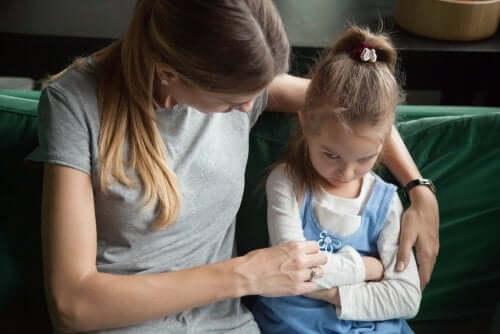PERA Technique to Set Limits for Children


Written and verified by the psychologist Mara Amor López
Some of the most frequent concerns as parents are to give our children a good education and to make them happy. For this reason, it’s very important that we establish limits that serve as a guide for the little ones. The PERA technique will be of great help in this task.
Limits are necessary for our children to grow up knowing how to live with respect and cordiality towards the people around them. Therefore, limits help them find their way and develop in a natural way. In addition, they provide security, which will reinforce their self-esteem and self-confidence.
If you want to know how to set limits using the PERA technique, read on.
PERA technique for setting limits
Marta Prada, Montessori guide, family educator and author of Educar en la felicidad (In English: “Educate in happiness”), speaks of “PERA free limits.” According to the acronym in Spanish, this means that we must avoid:
Constant prohibitions (Prohibiciones constantes)
No one likes to be constantly being told what NOT to do. “Don’t cry“, “Don’t yell“, “Don’t run“… So, we should avoid setting negative limits and transform them into more positive ones. For example, instead of “don’t yell“, it’ll work better “I hear you without you raising your voice.”

Labelling (Etiquetas)
“You’re bad“, “You’re lazy“, “You’re dumb“… In the end, labels will make children change the way they perceive themselves, and they’ll end up believing they’re what you tell them.
Resentment (Resentimientos): another aspect to avoid according to the PERA technique
We should never set limits out of resentment. Sometimes, we’re angry because our children have done something wrong or, perhaps, we’ve had a bad day and our children end up paying for it when we act out of resentment.
Threats or punishments (Amenazas o castigos)
These can work in the short term, as children stop doing what they were doing because of the punishment we suggested. But it’s not a technique that respects children’s emotions and it won’t have a positive effect in the long run.
The PERA technique: other keys to setting limits according to Montessori
Previously, we’ve seen what we should avoid when setting limits, but we must also take into account other considerations:
When setting limits, we must always take into account the children’s needs
This means that we must adapt the way we speak to them as they grow. For example, with younger children, it’s best to use short and simple sentences, but from the age of 3, we can use more complex questions allowing them to explain and repair their mistakes.
Limits shouldn’t be noticeable
For children, limits are a guide to know how they should behave. We shouldn’t fix and order limits, but rather instill them, so that children respect them and don’t see them as prohibitions.
Respect your children and also their safety
We must establish limits in situations in which our children can endanger their own integrity.
Limits must be flexible
Common sense must always prevail when setting limits. The situation and context must always be taken into account.

Children’s mistakes shouldn’t be targeted
We must respect the nature and emotions of children, establishing limits in a more positive way.
Explain why
When children understand why we set certain limits, perhaps because it’s a dangerous situation for them or for others, they’ll be motivated to comply.
We must be firm in complying with the PERA technique
Once limits have been established, we must always comply with them. For example, varying the time to go to bed, one day at one hour, another day at another…
In the end, this limit is impossible to comply with because it’s varied application makes children resist it. Therefore, these routines must always be respected, no matter the day.
If you’ve read up to this point, you realize how important it is to establish limits for children in order to give them a good education and, also, to make them happy. That’s why the PERA technique can help you in this task, highlighting everything you should avoid in this process. We mustn’t forget that setting healthy limits is a gesture of love from parents towards their children.
Some of the most frequent concerns as parents are to give our children a good education and to make them happy. For this reason, it’s very important that we establish limits that serve as a guide for the little ones. The PERA technique will be of great help in this task.
Limits are necessary for our children to grow up knowing how to live with respect and cordiality towards the people around them. Therefore, limits help them find their way and develop in a natural way. In addition, they provide security, which will reinforce their self-esteem and self-confidence.
If you want to know how to set limits using the PERA technique, read on.
PERA technique for setting limits
Marta Prada, Montessori guide, family educator and author of Educar en la felicidad (In English: “Educate in happiness”), speaks of “PERA free limits.” According to the acronym in Spanish, this means that we must avoid:
Constant prohibitions (Prohibiciones constantes)
No one likes to be constantly being told what NOT to do. “Don’t cry“, “Don’t yell“, “Don’t run“… So, we should avoid setting negative limits and transform them into more positive ones. For example, instead of “don’t yell“, it’ll work better “I hear you without you raising your voice.”

Labelling (Etiquetas)
“You’re bad“, “You’re lazy“, “You’re dumb“… In the end, labels will make children change the way they perceive themselves, and they’ll end up believing they’re what you tell them.
Resentment (Resentimientos): another aspect to avoid according to the PERA technique
We should never set limits out of resentment. Sometimes, we’re angry because our children have done something wrong or, perhaps, we’ve had a bad day and our children end up paying for it when we act out of resentment.
Threats or punishments (Amenazas o castigos)
These can work in the short term, as children stop doing what they were doing because of the punishment we suggested. But it’s not a technique that respects children’s emotions and it won’t have a positive effect in the long run.
The PERA technique: other keys to setting limits according to Montessori
Previously, we’ve seen what we should avoid when setting limits, but we must also take into account other considerations:
When setting limits, we must always take into account the children’s needs
This means that we must adapt the way we speak to them as they grow. For example, with younger children, it’s best to use short and simple sentences, but from the age of 3, we can use more complex questions allowing them to explain and repair their mistakes.
Limits shouldn’t be noticeable
For children, limits are a guide to know how they should behave. We shouldn’t fix and order limits, but rather instill them, so that children respect them and don’t see them as prohibitions.
Respect your children and also their safety
We must establish limits in situations in which our children can endanger their own integrity.
Limits must be flexible
Common sense must always prevail when setting limits. The situation and context must always be taken into account.

Children’s mistakes shouldn’t be targeted
We must respect the nature and emotions of children, establishing limits in a more positive way.
Explain why
When children understand why we set certain limits, perhaps because it’s a dangerous situation for them or for others, they’ll be motivated to comply.
We must be firm in complying with the PERA technique
Once limits have been established, we must always comply with them. For example, varying the time to go to bed, one day at one hour, another day at another…
In the end, this limit is impossible to comply with because it’s varied application makes children resist it. Therefore, these routines must always be respected, no matter the day.
If you’ve read up to this point, you realize how important it is to establish limits for children in order to give them a good education and, also, to make them happy. That’s why the PERA technique can help you in this task, highlighting everything you should avoid in this process. We mustn’t forget that setting healthy limits is a gesture of love from parents towards their children.
This text is provided for informational purposes only and does not replace consultation with a professional. If in doubt, consult your specialist.








